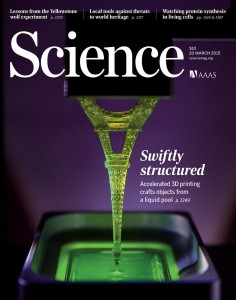As manufacturers catch on to the technology as faster and less expensive, 3-D printing is making significant inroads in the arena, applying it to high-volume manufacturing.
The updated methods are being used to produce a five-centimeter tall model of the Eiffel Tower, among a growing number of applications. A new additive manufacturing technology is 25 to 100 times faster than conventional 3-D printing, producing items such as parts that are stronger and less expensive to make.
Carbon3D, a start-up company founded in 2013, developed the method.
Continuous Liquid Interface Production — is a breakthrough technology that grows parts instead of printing them layer by layer. CLIP allows businesses to produce commercial quality parts at game-changing speeds, creating a clear path to 3D manufacturing.
3-D printing creates an object by depositing sequential layers of material. It isn’t as fast or as low-cost as conventional processes, but it lends itself to complex objects. Companies such as Carbon3D say it is fast enough to compete with usual mass manufacturing.
Watching a complex object rise, such as a geodesic ball, seemingly miraculously out of a layer of liquid, is convincing. The object appears continuously, rather than in discrete layers, so a finished item emerges faster. The materials are engineered to solidify when exposed to light. Under earlier 3-D processes, the laser must be turned off after each layer so more liquid can be spread out. This process slows the time to finished product and the interfaces between layers may be weak points in the finished product.
The newer technology is related to stereolithography, with a laser tracing a pattern on liquid. The Carbon 3D researchers, who are affiliated with North Carolina State University, figured out a way to make the process continuous, with no interfaces between layers, eliminating weak spots. Key is a modification in the liquid that prevents immediate solidification when exposed to light. A thin layer of oxygen temporarily stalls the chemical reactions leading to a solid.

The process has been proven to work with a variety of commercial plastics and the research continues on different liquids. The North Carolina group has raised more than $41 million in venture funding to continue the work.
Predictions that 3-D printing would replace conventional manufacturing in the near future seem to be materializing faster than many would have predicted.
